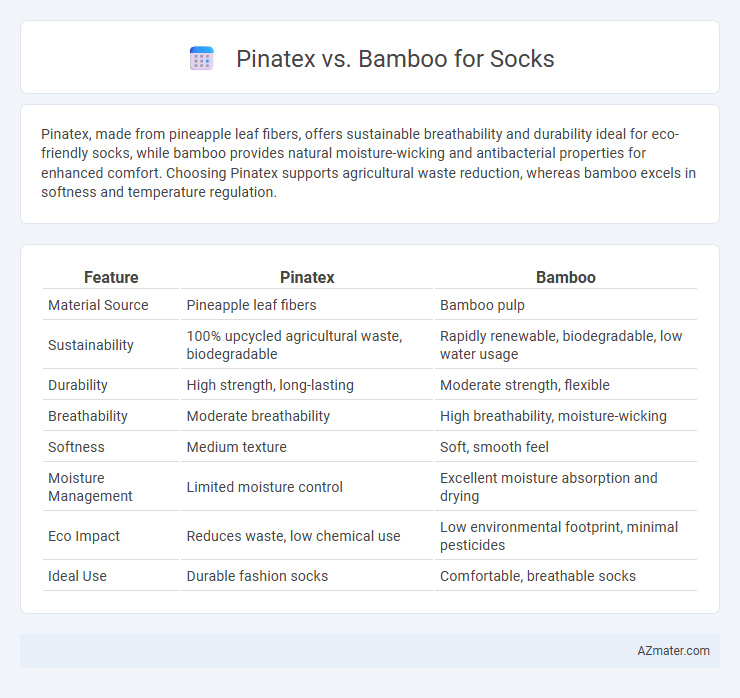Pinatex, made from pineapple leaf fibers, offers sustainable breathability and durability ideal for eco-friendly socks, while bamboo provides natural moisture-wicking and antibacterial properties for enhanced comfort. Choosing Pinatex supports agricultural waste reduction, whereas bamboo excels in softness and temperature regulation.
Table of Comparison
| Feature | Pinatex | Bamboo |
|---|---|---|
| Material Source | Pineapple leaf fibers | Bamboo pulp |
| Sustainability | 100% upcycled agricultural waste, biodegradable | Rapidly renewable, biodegradable, low water usage |
| Durability | High strength, long-lasting | Moderate strength, flexible |
| Breathability | Moderate breathability | High breathability, moisture-wicking |
| Softness | Medium texture | Soft, smooth feel |
| Moisture Management | Limited moisture control | Excellent moisture absorption and drying |
| Eco Impact | Reduces waste, low chemical use | Low environmental footprint, minimal pesticides |
| Ideal Use | Durable fashion socks | Comfortable, breathable socks |
Introduction to Sustainable Sock Materials
Pinatex and bamboo are innovative sustainable materials transforming sock manufacturing by offering eco-friendly alternatives to conventional fibers. Pinatex, derived from pineapple leaf fibers, provides a durable and breathable textile while promoting agricultural waste utilization. Bamboo, known for its rapid growth and natural antibacterial properties, delivers softness and moisture-wicking benefits, making both materials appealing for sustainable socks focused on reducing environmental impact.
What is Piñatex?
Pinatex is an innovative sustainable material made from pineapple leaf fibers, offering a cruelty-free and eco-friendly alternative to traditional textiles. It is highly breathable and durable, making it an excellent choice for socks that prioritize comfort and environmental impact. Compared to bamboo, Pinatex provides a unique texture and strong fiber structure that enhances the lifespan and performance of eco-conscious socks.
What is Bamboo Fiber?
Bamboo fiber is a natural textile material derived from the pulp of bamboo plants, known for its softness, breathability, and moisture-wicking properties, making it ideal for sock manufacturing. It is biodegradable and sustainable, as bamboo grows rapidly with minimal environmental impact, offering a renewable alternative to synthetic fibers. Compared to Pinatex, which is a leather-like material made from pineapple leaf fibers, bamboo fiber provides superior comfort and flexibility for everyday wear in socks.
Production Process: Piñatex vs Bamboo
Pinatex is produced from pineapple leaf fibers, a sustainable byproduct of pineapple farming, involving a non-woven mesh extraction process that reduces waste and energy consumption. Bamboo fabric creation includes harvesting bamboo stalks, followed by chemical processing into viscose or lyocell, which may involve higher environmental impact due to chemical use and intensive water consumption. Pinatex's production emphasizes waste utilization and low-impact methods, while bamboo requires more resource-intensive chemical treatment, influencing their sustainability profiles for sock manufacturing.
Environmental Impact Comparison
Pinatex and bamboo both offer sustainable alternatives for sock materials, with Pinatex derived from pineapple leaf fibers, reducing agricultural waste, while bamboo is a fast-growing grass that requires minimal pesticides and water. Pinatex production utilizes agricultural byproducts, promoting circular economy practices, whereas bamboo's rapid growth and natural antibacterial properties contribute to reduced chemical use and longer sock lifespan. Both fibers help decrease reliance on conventional cotton and synthetic fabrics, significantly lowering water consumption, carbon footprint, and soil degradation in sock manufacturing.
Comfort and Breathability in Socks
Pinatex socks offer excellent breathability due to their natural pineapple leaf fiber composition, allowing moisture-wicking and temperature regulation for enhanced comfort. Bamboo socks provide superior softness with inherent hypoallergenic and antimicrobial properties, ensuring a smooth, irritation-free fit ideal for sensitive skin. Both materials excel in comfort, though Pinatex emphasizes durability and airflow, while bamboo prioritizes softness and moisture management.
Durability and Longevity
Pinatex, made from pineapple leaf fibers, offers excellent durability with its natural tensile strength and resistance to wear, making it suitable for long-lasting sock uppers or accessories. Bamboo fibers are known for their softness and antimicrobial properties but tend to have lower abrasion resistance compared to Pinatex, potentially reducing overall longevity in high-friction sock applications. Combining Pinatex's robust performance with bamboo's comfort can create a balanced sock material that ensures both durability and wearer satisfaction.
Style and Aesthetic Differences
Pinatex socks offer a unique, textured surface derived from pineapple leaf fibers, creating a natural, rustic aesthetic that appeals to eco-conscious fashion enthusiasts. Bamboo socks feature a smooth, silky finish with a slight sheen, lending a clean, modern look that complements minimalist and contemporary styles. The distinct fibrous structure of Pinatex contrasts with the fine, uniform weave of bamboo, making each material suited to different fashion statements and lifestyle preferences.
Cost Comparison and Market Availability
Pinatex socks typically cost 20-30% more than bamboo socks due to the innovative use of pineapple leaf fibers and sustainable production methods. Bamboo socks are widely available in mainstream retail and online markets, benefiting from established supply chains and lower raw material costs. Pinatex remains niche but is gaining presence in eco-conscious and premium sustainable fashion segments, reflecting its limited but growing market availability.
Which is Better for Socks: Piñatex or Bamboo?
Pinatex, made from pineapple leaf fibers, offers exceptional durability and breathability, making it a sustainable choice for socks that require strength and moisture management. Bamboo fibers provide natural antibacterial properties and a silky softness, ideal for sensitive skin and comfort in everyday wear. For socks, bamboo is often preferred due to its superior softness and moisture-wicking abilities, whereas Pinatex excels in durability and eco-friendly impact.

Infographic: Piñatex vs Bamboo for Sock
 azmater.com
azmater.com